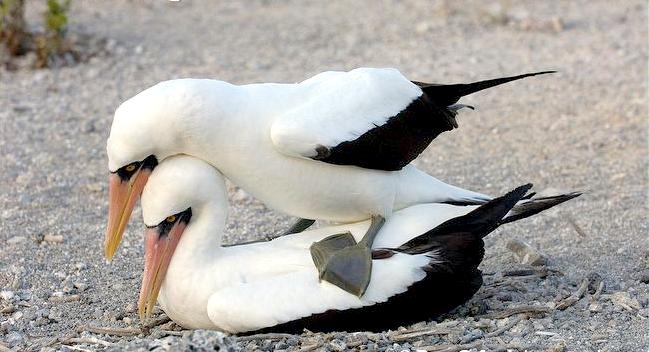“Sula granti”
With its bright orange colored beak & eyes, contrasting plumage tones and black, bare facial skin, the Nazca Booby is one of the Galápagos Islands most charismatic bird species. Previously considered to be a subspecies of the more widespread Masked Booby, the Nazca Booby is now recognized as a distinct species. Nazca is a system of valleys on the southern coast of Peru where these seabirds were first observed. It is also the name of the largest existing town in the Nazca Province. The name is derived from the Nazca culture that flourished in the area between 100 BC & 800 AD. The word “booby” comes from the Spanish “bobo” meaning “stupid fellow” and was probably inspired by the bird’s clumsiness on land. They are extremely vulnerable to human visitors because they do not appear to fear us. The head and body of the Nazca Booby are almost entirely pristine white, except for the tail and the trailing edge of the wing, which are a rich, reddish tinged, chocolate brown. The bill color varies between populations on different islands, but is usually bright orange in the male and rosy pink or pinkish-orange in the female. The iris is orange and stands out in stark contrast against the surrounding black facial skin, while the bare skin of the feet & legs can vary from olive to blue-gray. Juvenile Nazca Boobies have grayish-brown plumage on the back, head & neck with diffuse, pale flecking. Feeding in the near-shore waters surrounding oceanic islands or along the coasts of Central and South America, the Nazca Booby can be seen making dramatic plunge dives from heights of up to 30 meters into schools of fish. Populations on the Galápagos Islands mostly favor schools of sardines, but during El Niño years when these fish are scarce, the birds will instead prey on flying fish.
The Nazca Booby breeds at different times throughout the year according to the location of the nesting colony. A minimal nest is constructed with a few small pebbles laid on the ground, in which 2 eggs are laid a few days apart. Interestingly, incubation involves the parent bird wrapping both its feet around the sides & top of the eggs, transferring heat from the dense network of blood vessels in the webbing between the digits. Nazca Booby chicks engage in siblicide, a behavior in which the first chick to hatch after the 40-day incubation period invariably attacks the second chick and pushes it out of the nest. The parent birds ignore this battle and leave the second chick to die of starvation or as a result of having its wounds pecked by blood-feeding birds. The reason for such seemingly unnecessarily destructive behavior is suggested to be because the second egg’s only purpose is to act as insurance in case the first egg does not hatch. Therefore, in cases where both eggs hatch, the second offspring could represent an extra energetic burden on the parent birds to feed it, particularly in years of low food supply. The remaining chick fledges after around 115 days, but does not reach sexual maturity and begin breeding until 3 to 4 years old. The Nazca Booby is found on several Pacific Ocean islands off the coast of Colombia, Ecuador and Central America. The largest nesting colonies occur on the Galápagos Islands located off the coast of Ecuador and Malpelo Island, situated off the coast of Colombia with much smaller numbers breeding on Isla La Plata and San Benedicto Island located off the coasts of Ecuador & Mexico. In addition, Nazca Boobies have recently been observed nesting on the Hawaiian Islands.







































